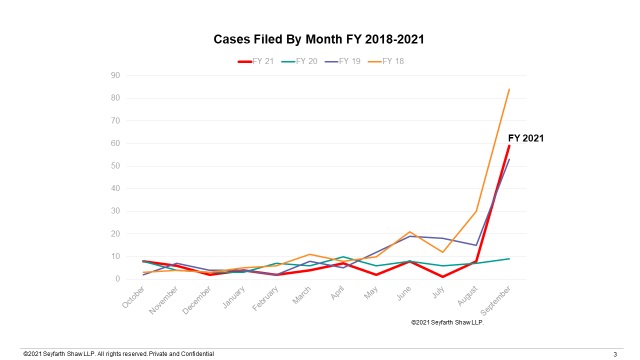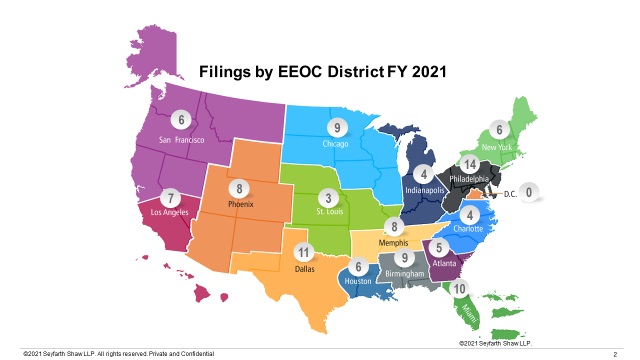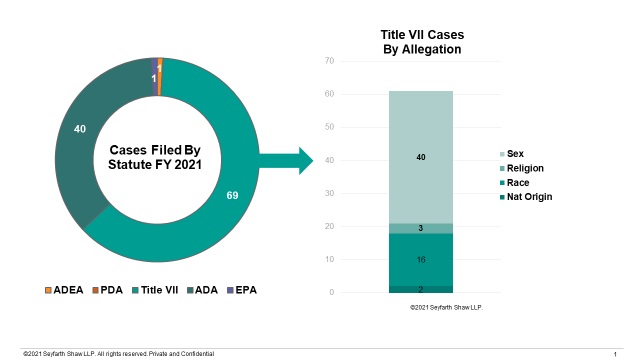Seyfarth Synopsis: Following the EEOC's down 2020 fiscal year, in which the Commission made significant changes to many of its programs in the midst of the global COVID-19 pandemic and leadership changes, in FY 2021 the EEOC's litigation enforcement activity showed signs of recovering from the lingering pandemic. The number of cases filed by the EEOC increased in a respectable climb back to pre-pandemic levels, forecasting a busy year ahead for the Commission and employers in FY 2022.
For the most of the last 25 years, the EEOC's Fiscal Year ended with a surge in last-minute lawsuits. August and September filings often eclipsed the entire rest of the year combined. Following a "down year" in FY 2020 where only 33 lawsuits were filed in September, the finish in FY 2021 represented a return to form, with 59 lawsuits filed during September (similar to the 52 filed in September of FY 2019, and 84 in FY 2018). At the time of publication of this blog posting, the EEOC filed 114 total cases in FY 2021, which includes 111 merits lawsuits and 3 subpoena enforcement actions. This total number of filings is more than last year's total of 101 lawsuits (see here), but still less than the last two years prior (see here and here).
Cases Filed By EEOC District Offices
In addition to tracking the total number of filings, we closely monitor which of the EEOC's 15 district offices are most actively filing new cases. Some districts tend to be more aggressive than others, and some focus on different case filing priorities. The following chart shows the number of lawsuit filings by EEOC district office.
The most noticeable trend of FY 2021 is the filing dip in some key regions compared to past years. The New York district office fell from 12 filings in FY 2020 to 6 filings in FY 2021. The California district offices in San Francisco and Los Angeles, which combined for 16 new filings last year, declined in FY 2021, coming at a combined total of 13 new filings, including San Francisco's fall from 10 to 6. The Indianapolis district office, which had a huge year in FY 2020 with a nation-leading 13 filings, returned to the middle of the pack with only 4 filings this year.
On the other hand, leading the pack in new filings was the Philadelphia district office with 14 filings. Chicago's filings shot up from 3 filings last year to 9 filings this year, and the Dallas district office made a similarly large jump from 5 filings from FY 2020 to 11 filings in FY 2021. The Birmingham district office also made a noticeable move from 5 filings in FY 2020 to 9 filings in FY 2021. Overall, following a substantial decline in litigation enforcement activity in FY 2020, the increase filings in FY 2021 suggests the EEOC is back on track at most of its regional offices across the country.
Analysis Of The Types Of Lawsuits Filed In FY 2021
Each fiscal year we also analyze the types of lawsuits the EEOC files, in terms of the statutes and theories of discrimination alleged, in order to determine how the EEOC is shifting its strategic priorities. Those numbers at least - when considered on a percentage basis - are in line with the numbers we have seen the last few years. The graphs below show the number of lawsuits filed according to the statute under which they were filed (Title VII, Americans With Disabilities Act, Pregnancy Discrimination Act, Equal Pay Act, and Age Discrimination in Employment Act) and, for Title VII cases, the theory of discrimination alleged.
When considered on a percentage basis, the distribution of cases filed by statute remained roughly consistent compared to FY 2020 and 2019. Title VII cases once again made up the majority of cases filed, making up 62% of all filings (on par with the 60% in FY 2020 and 60% in FY 2010). ADA cases also made up a significant percentage of the EEOC's filings, totaling 36% this year, a moderate uptick from 30% in FY 2020. There was only one age discrimination case filed in FY 2021, down seven from FY 2020.
February 2021 Release Of Enforcement Statistics
On February 26, 2021, the EEOC released its comprehensive enforcement and litigation statistics for FY 2020 (available here). The dip in the number of charges that employers saw in 2018 and 2019 continued through 2020, with the number of charges reaching its lowest point since 1997. The prominence of gender discrimination charges seen in 2018 due to the #MeToo movement has all but disappeared, with sex discrimination charges remaining in the fourth-place position and dropping to their lowest number in over 20 years. When the FY 2021 figures are released in the coming months, we do not expect there to be much departure from this trend.
However, monetary benefits recovered by the Commission in FY 2020 surged. The EEOC recovered a record amount of $535.4 million on behalf of alleged discrimination victims. By comparison, the EEOC recovered approximately $486 million in FY 2019; approximately $505 million in FY 2018; and approximately $484 million in FY 2017. When the final figures are released for FY 2021, we anticipate there will be a similar eye-popping dollar amount of recoveries.
January 2021 Release Of Annual Performance Report
On January 19, 2021, the EEOC released its second-ever Annual Performance Report ("APR") for FY 2020 (see here). In essence, it is a report card on the Commission's activities, including its record relative to enforcement litigation. That said, the APR is an analysis of the EEOC's litigation goals and performance results, and contains important data points regarding the EEOC's changing strategic objectives and potential future targets of heightened enforcement activity.
In what can be considered a potential explanation for the decline in lawsuits, during FY 2020, the Commission conducted 6,272 mediations, resulting in $156.6 million in relief to charging parties. Further, 766 federal sector mediations were conducted, reducing the inventory of federal sector disputes. Overall, approximately $333.2 million in relief was recovered through mediation, conciliation, and settlements.
When this data is later released for FY2021, given the shutdowns in the courts coupled with the surge of virtual mediations, we anticipate the number of mediations and recoveries will remain significant.
Implications For Employers
FY 2020 was a year of whirlwind change at the EEOC as a result of the pandemic and leadership changes, and the FY 2021 aftermath resulted in strikingly similar results. Now that the new leadership regime and their structural changes are finally settling in to a world that remains hampered by a lingering global pandemic, employers find themselves once again looking out over an uncertain future of the employment landscape. It remains to be seen how new priorities and strategies will impact their businesses in FY 2022, especially when many businesses are shifting to remote work structures that may limit some of the common catalysts of workplace discrimination.
We will continue to monitor these changes closely and keep readers apprised of developments. Our annual comprehensive analysis of trends in EEOC litigation will be published at the end of the calendar year. As always, we will keep abreast of EEOC data amid the ever-changing political milieu, and share lessons learned from FY 2021 to carry employers through the new year.
Readers can also find this post on our EEOC Countdown blog here.
The content of this article is intended to provide a general guide to the subject matter. Specialist advice should be sought about your specific circumstances.







